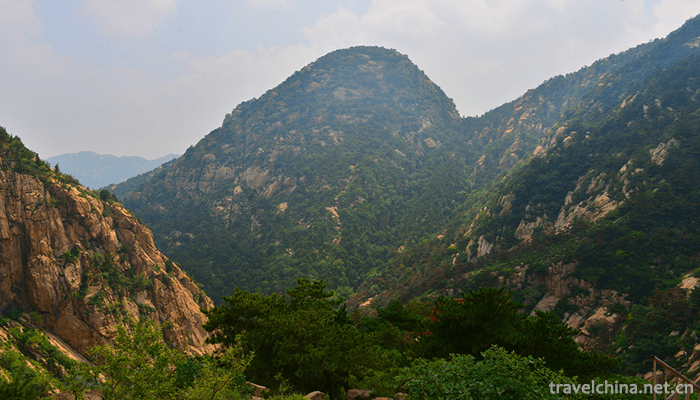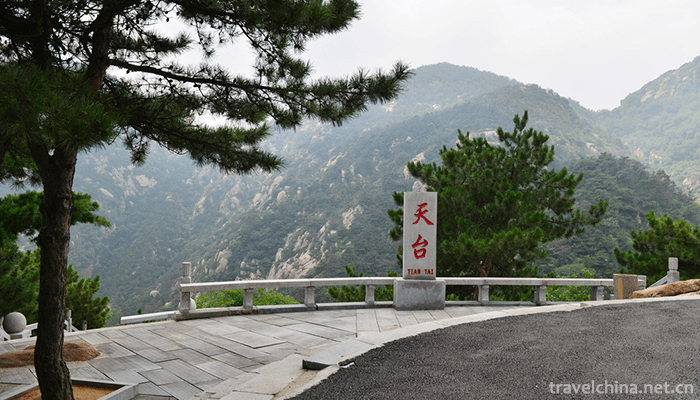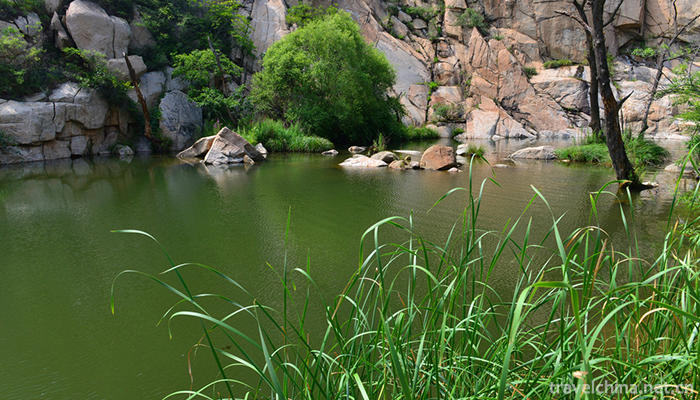Fanggan Ecological Scenic Area
Fanggan Eco-tourism Area is located in Luye Township in the north of Laiwu City. It is bordered by Jinan in the north, Zibo in the East and Taian in the west. National Highway 09 is very convenient for traffic. The tourist area is near 1000 meters above sea level and belongs to Mount Taishan Mountains. It has beautiful scenery, beautiful scenery, beautiful birds and flowers, and is praised as "green paradise" by international environmental experts. Good ecological and environmental protection, forest vegetation coverage accounts for 90%, is now striving to be included in the United Nations "500 global ecological and environmental protection".
All the scenic spots are greened. There are nearly 100 kinds of plants, more than 20 kinds of wildlife and more than 100 kinds of birds in the scenic area, and eight reservoirs. With the characteristics of eco-environmental protection and the theme of green, Huishan, water, forest, spring, pool, waterfall, gorge, cave, stone and other natural landscapes in one place constitute the tourism content of the three major plates of eco-environmental protection, natural landscape and folk customs, which are praised as "green paradise" and "mountain pearl" by international environmental protection experts. The main landscapes of Fanggan include Jiulong Grand Canyon, Jintai Mountain, Shiyun Mountain, Tianmen Gorge, Peach Blossom Source, Longevity Cliff, Riguanfeng, etc. Every year from July to August, "Fanggan Ecotourism Festival" is held, which includes viewing natural scenery, experiencing farm life customs, watching literary and artistic performances, etc.
The Kowloon Grand Canyon is 20 kilometers long. The ancient trees are towering in the middle of the canyon. The peaks on both sides are abrupt. Mountains, springs, pools, waterfalls and caves are distributed in the canyon. So far, the original style has been maintained. Mount Jintai is a magnificent mountain, resembling Mount Tai. There are Gongbei Stone, Luohan Stone, Python and other landscapes on the top of the mountain. Shiyun Mountain is 840 meters above sea level, and there are many strange stones on it. Tianmen Gorge is located at the north foot of Shiyun Mountain, about 5 miles long. The Valley is crisscrossed with Valentine's Valley, Longfeng Valley, Luming Valley and Butterfly Valley. There are also dumpling stones, precious stones, potted stones and other landscapes.
Main attractions
The eight major scenic spots in the tourist area are Jiulong Grand Canyon, Jintai Mountain, Heilongtan, Wanghai Peak, Xianren Cave, Skyscraper, Dripping Cliff and Wulaofeng, which are the main development zones. There are more than 40 scenic spots in the area, including mountains, waters, forests, springs, pools, waterfalls, Gorges and caves. They combine the folklore of historical figures such as Huangchao, Li Ben, Zhang Daoyi, Chen Ganyu and bald-tailed Lao Li. It has the charm of natural scenery, humanistic landscape and ecological environment protection. It attracts Chinese and foreign tourists. It is a good place for sightseeing, tourism, vacation and leisure. Therefore, the development of Fanggan Ecotourism Area has great economic and social benefits.
Kowloon Grand Canyon
It spans two townships, Dawangzhuang and Xueye, and traverses 15 hills, ranging from Longwei to Fanggan, with a total length of about 10 kilometers. The ancient trees in the valley are towering, and the odd peaks on both sides are abrupt. Mountains, springs, pools, waterfalls and caves are distributed in the valley. So far, they have kept their original features. There are Wolong Gorge, Xinghua Village, Zhaobifeng, Heilongtan, Longnutan, Longmen Lake and other landscapes. Tan Tan connected, waterfalls connected, there is a poem said: "Longyin deep pool Eagle love peak, Chirizhao wall see silver stars. Longtan scenery is poetic, Laiwu River Mountain scenery is magnificent.
Kim Taishan
At 840 meters above sea level, the mountain peaks rise abruptly, and there are three cliffs, which can only be climbed to the west. Legend has it that the Bixia Yuanjun of Mount Tai made a tour to the east, and the mountain is not vulgar. That is to say, according to the model of Mount Tai, it was changed by gold and fire. It is very similar to Mount Tai, so it is called "Mount Jintai". The seastone on the top of Mount Jintai, more than 9 meters long, is the landmark landscape of Mount Jintai, like a sword straight into the sky, with great ornamental value. To the west of the exploratory sea rocks, there are four huge stones overlapping each other. On the top, there is a round stone, showing a large Buddha head with broad forehead, high nose, broad mouth and narrow eyes. Among them, the long round stone is the stomach of the Buddha, and the two stones under it are the feet. The upper and lower feet are 40 meters high, and the distant view is like a Luohan, hence the name "Triassic Luohan". At the top of the mountain, there are also moving stones, pythons and other landscapes.
Shi Yunshan
At 860 meters above sea level, it is famous for its strange stone caves. After thousands of years of wind and rain erosion, the hills and valleys have formed smooth and round pebbles, which look like white clouds floating among green mountains and trees from afar. There are "Crouching Tiger Stone" in shape like a tiger, and "Dragon Stone" in shape like Jiaolong, as well as "Eagle-billed Stone", "Love Margin Stone", "Golden Turtle Stone", "Hengkong Birth", "Wordless Stele" and so on. They have different shapes, vivid, spiritual and life, and each has its own origin and story. Under the Baiyan, numerous caves have been formed, some as large as the living room, some as deep as unfathomable, and some caves are connected, one of which penetrates through the mountain body, which is of great ornamental value. The ballad says, "Shiyun Mountain, Shiyun Mountain, seventy-two caves inhabit immortals".
There are also two huge stones on the top of the mountain, which are arranged from left to right. There are 20 meters wide avenue leading directly to Tianjie, forming a natural stone gate, engraved with the word "Tianmen", simple and solemn, and integrated with the landscape. At the south foot of Shiyun Mountain, there are four mountains: Tianwang Mountain, Fenghuang Mountain, Jinguiling Mountain and Foguangling Mountain. There are five valleys: Fengyue Valley, Qingyun Valley, Crouching Tiger Valley, Panlong Valley and Leijian Valley.
Tianmen Gorge
At the north foot of Shiyun Mountain, about 5 miles long, the valley is crisscrossed with Valentine Valley, Longfeng Valley, Luming Valley, Butterfly Valley, and there are huge dumpling stones, precious stones, potted stones and other landscapes.
The Peach Garden
"Hidden flying bridges are separated by wild smoke, fishing boats are asked on the West Bank of Shiji, flowers are picked everyday and water is flowing. Where is the hole in the Qingxi River". Zhang Xu's poem "Peach Blossom Source" and Tao Yuanming's "Peach Blossom Source Record" are both popular poems. Mao Zedong once wrote, "Tao Ling does not know where to go, and peach blossom Source can cultivate fields". Although Fanggan's Peach Blossom Source is not related to the above poems, its geographical environment and landscape are strikingly similar to the ancient Peach Blossom Source. Peach blossom is a green world, the valley bottom of ancient trees towering, shading the sky, hills and grasses, a dark green, occasionally several peach trees in the "green bushes in a little red" in her extraordinary beauty. The gushing mountain springs and gurgling streams also seem to be flowing endlessly green.




0 Questions
Ask a Question
Your email address will not be published.